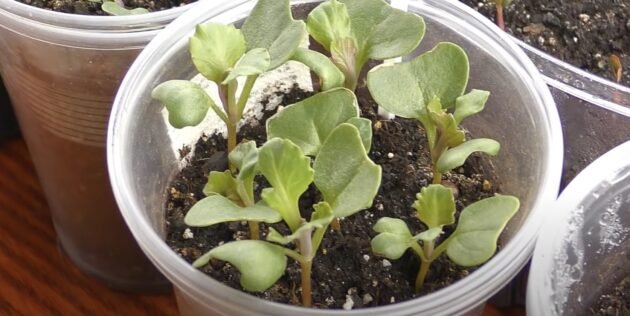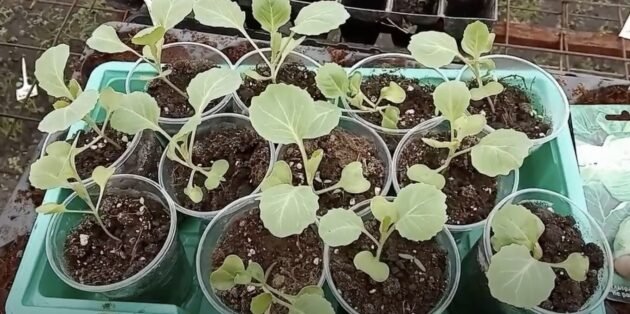At the initial stage of their development, young plants are particularly in need of thorough nutrition. Nitrogen will help cabbage to build up a green mass and form a strong stem, phosphorus is responsible for the development of the root system, and potassium is needed for tying the head.
In total, cabbage seedlings will need three top dressing. The first is carried out when the sprouts release two real leaves, after 10-12 days — the second (usually at this time another pair of leaves appears), and the third — about a week before the expected planting of plants on the beds.

Additional nutrition will help the cabbage to get stronger faster and start growing.
Prepare one of the nutrient solutions and carefully pour the sprouts under the root, trying not to get on the leaves. To do this, it is convenient to use a syringe or a syringe. Make sure that the soil in the seedling cups is moist. For one plant, you will need about 1 teaspoon of the mixture.
At the start of development, you can treat cabbage with a solution of liquid vermicompost. To do this, dilute 5 ml of fertilizer in 1 liter of water. Leave the solution in a warm place and let it infuse for 4 hours. Then pour the cabbage under the root at the rate of 10-15 ml of the mixture per plant.

Grown plants will need a slightly higher concentration of nutrients than during the first fertilizing .
Prepare one of the solutions and pour the cabbage under the root. One plant will need about 50 ml of the nutrient mixture.
At this stage, you can use the same vermicompost-based solution that was used for the first top dressing (5 ml of the product per 1 liter of water), or prepare one of the mixtures below. Feed each bush with 50 ml of liquid.

At this stage, the plants will need a lot of phosphorus and potassium to form a dense head.
Shortly before planting in the ground, either root or foliar top dressing of cabbage seedlings can be carried out.
In the first variant, about 100-200 ml of the nutrient mixture should be poured under the root of one plant. The same fertilizers that were used for the first two fertilizing are suitable, but it is worth increasing the concentration. Or make a solution based on potassium monophosphate.
For foliar feeding seedlings cabbage, you will need a solution of boric acid. Dilute 1 teaspoon of the substance in 250 ml of boiling water. Dilute the resulting concentrate with 10 liters of water. Use this product to thoroughly spray the leaves from the inside and outside. It is also better to do this in the evening.
All the same solutions of vermicompost (5 ml of the product per 1 liter of water) and potassium humate (10 ml of the product per 1 liter of water) are suitable for fertilizing. About 200 ml should be poured under the root of one plant.
Yeast will also help stimulate the growth of cabbage. To do this, thoroughly dissolve 3 g of dry yeast in 3 liters of warm (not hot) water. Let the mixture stand in a warm place for 3 hours. Dilute the finished solution with 10 liters of water and pour the cabbage under the root. 100-200 ml of fertilizer is enough for one bush.